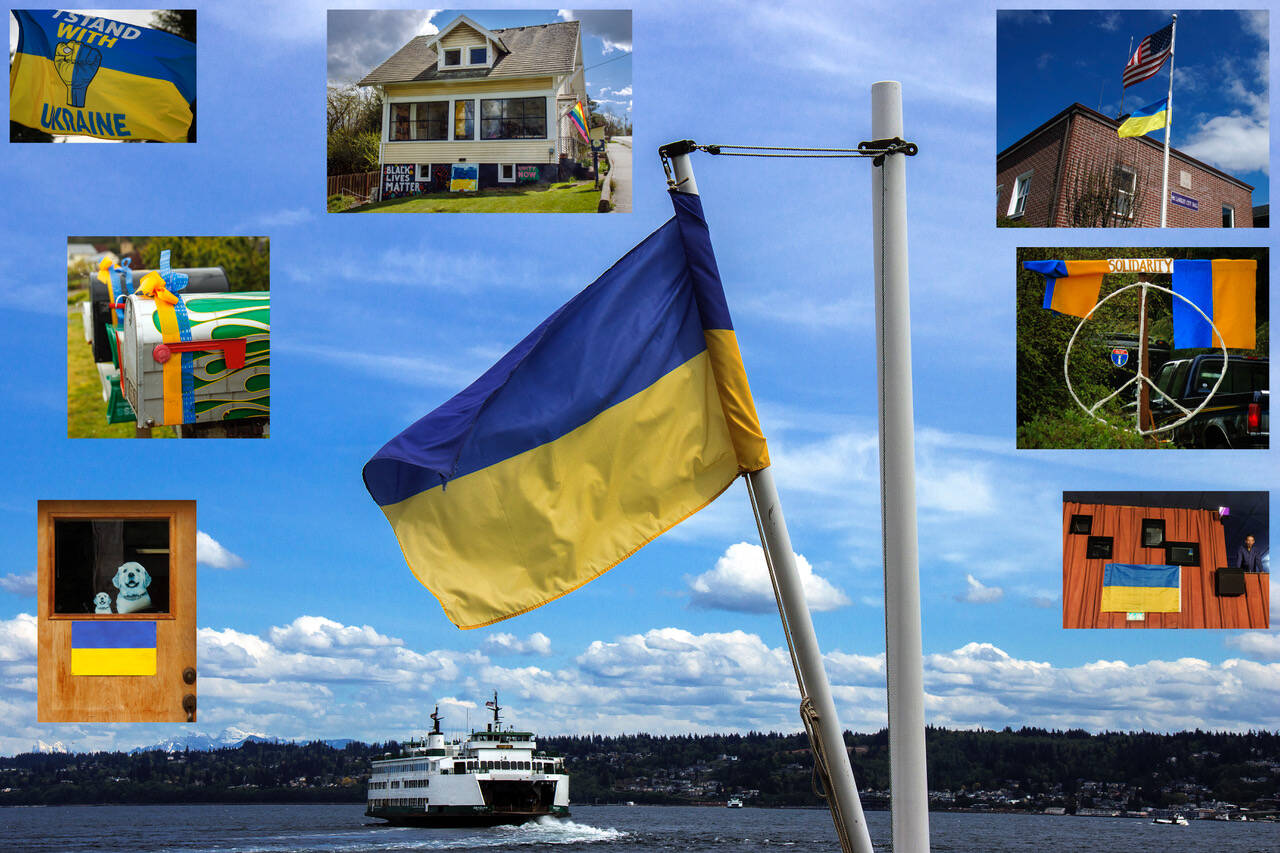A Freeland woman is devastated to see what Russia is doing to her native Ukraine, and the small country town of her childhood, where her father still lives.
Yet her heart is lifted when she travels around Whidbey Island and sees the many flags raised in support of her homeland.
“I’m very proud of the people of Ukraine and the United States for resisting the unprovoked invasion by Russia,” said Natasha Sheldon of Freeland. “The way people on Whidbey display flags and other symbols with Ukrainian colors give a strong sense of confidence.”
As she stays in frequent phone contact, Sheldon said her relatives in the war zone are aware of how Whidbey residents are expressing support. Even in the middle of a war, it’s much easier than ever to share information, she said.
“People are worried and scared,” she said. “Knowing there are Ukrainian flags on Whidbey give people comfort and confidence. Whidbey is a long way from Ukraine. I knew nothing about Whidbey when I came here in 2002.”
Sheldon said her father still lives in Lebedyn, in the Sumy Oblast (province) of northern Ukraine near the Russian border. The military threat, she explained, is less because there are fewer targets in Sumy, and the Russian objective is to push south to Kyiv.
A few inconsequential military clashes are known as the “Battle of Lebedyn.” Heavy military equipment tore up the new roads built in recent years. Some civilians were allowed to leave.
Sheldon visited her father last September and talked about preparing for invasion. She said people didn’t believe warnings even as late as February, when her sister visited from Italy.
According to Sheldon, the Sumy Oblast was thriving with factories, food production, and mercantile activity during her childhood. Poor economic conditions led to decline of what used to be a regional center. Most of the people who stayed are elderly retirees, Still, she said, the people are brave and steadfast.
“The Russian plan to capture Kyiv in three days didn’t work well,” Sheldon said.
She proudly tells of one occasion when four Russian tanks came into a village. The Russians left in two tanks, leaving two behind. Villagers put Ukrainian flags on the empty tanks. The Russians returned, saw the flags, believed the tanks were Ukrainian, and blew up the vehicles. The remaining tanks tried to cross a weak bridge and fell into the river. “The villagers won the battle without any bullets!” Sheldon said.
“Russia and Ukraine have always been in competition, with Russia trying to rewrite our history,” declared Sheldon. “The modern weaponry support from the U.S. is helping the committed Ukrainian forces effectively defend their territory.”
Since the Soviet Union dissolved in the mid-1980s, Sheldon explained, the Russians have conducted extensive propaganda campaigns, even placing sympathizers in the Ukrainian Duma (parliament). She said Ukraine has long been a focus of Russian repression.
“The people of Ukraine continue to fight bravely for their own land. Volodymyr Zelenskyy has proven to be a good leader and effective president,” she commented.
“Remember, Ukraine has the rich heritage of the Cossack fighters,” she said. “The national anthem speaks directly of the irrepressible spirit (‘Ukraine has not yet perished’).”
She said the way people of Whidbey display Ukrainian flags and symbols continue to speak of the tradition of independence.
The Ukrainian flag shows a blue upper horizontal stripe, said to represent the clear sky and mountains. The lower golden horizontal stripe represents the fields of grain and the richness of the land. The flag was prohibited when Ukraine was part of the Soviet Union. The bi-color was restored with Ukrainian independence in 1991.
The war also tests Ukrainian national unity and commitment to democracy, said Sheldon. Ethnic diversity and shifting boundaries give the area a tangled history unfamiliar to many Americans. Historians still debate Ukrainian origins and nationality. In the 20th Century, Ukraine developed into a more clearly defined nation.
For almost 500 years, Ukrainians struggled for territorial control with Poland, Lithuania, and more recently, Russia. A large peasant population, known as “Little Russians,” mingled with Turkish tribes. Cossacks were both integrated and separate, usually in the vanguard of fighting the Poles. There was a tradition of serf rebellion, especially against Russians. Jews scattered throughout Ukraine were occasionally targets of discrimination.
Sheldon thinks the Russian objective is to gain control of Eastern Ukraine to get a land route to Crimea. From the Crimean Peninsula, Russia would be better able to command activities in the Black Sea. Control of the east would also block Ukrainian access to the Sea of Azov and restrict grain exports.


